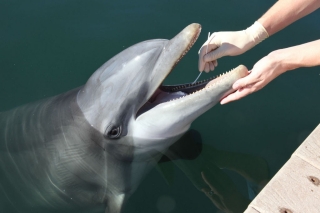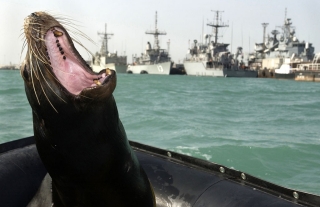By Steve Fyffe | Original post
The findings could help scientists detect potential health problems facing marine mammals due to climate change, as well as answer a mystery about how dolphins digest whole fish.

National Marine Mammal Foundation
School of Medicine researchers working with the U.S. Navy’s Marine Mammal Program in San Diego have discovered a startling variety of newly-recognized bacteria living inside the trained dolphins that the Navy uses to find submerged sea mines and detect underwater intruders. They found similar types of bacteria in wild dolphins as well.
“About three-quarters of the bacterial species we found in the dolphins’ mouths are completely new to us,” said David Relman, MD, professor of medicine and of microbiology and immunology. These previously unknown bacteria represent “whole new realms of life,” according to Relman, who is also co-director of the Center for International Security and Cooperation at Stanford and a senior fellow at the university’s Freeman Spogli Institute for International Studies.
A paper describing the research was published Feb. 3 in Nature Communications. Relman is the senior author. The lead author is Elisabeth Bik, PhD, a research associate in his lab.
“Bacteria are among the most well-studied microbes, so it was surprising to discover the degree to which the kinds of bacteria we found were types that have never been described,” Relman said. “Novelty doesn’t just mean new names of species, families, classes or phyla. … There’s reason to believe that, along with this taxonomic novelty, there’s functional novelty.”
Dolphin breath
The U.S. Navy has been training dolphins and sea lions to carry out defensive military missions from their bases in San Diego and elsewhere since the early 1960s.

U.S. Navy
Relman, who is also the Thomas C. and Joan M. Merigan Professor, started working with the Navy more than 15 years ago to identify bacteria suspected of causing stomach ulcers in their dolphins.
His latest project to catalog the bacterial communities, or microbiota, living inside the dolphins began when the Navy asked him to help develop a probiotic bacterial strain that could keep their dolphins healthy, or help sick dolphins get better.
Navy trainers took regular swabs from the dolphins’ mouths and rectal areas and shipped the samples to Stanford on dry ice for analysis.
They also collected samples of the respiratory fluids and other biological matter in the air that the dolphins exhaled from their blowholes onto sterile filter paper, as well as samples of their gastric juices using a tube that the dolphins would swallow on command, and, for comparison, bacteria from the surrounding water.
The study found a similar amount of diversity and novelty in bacterial samples taken from wild dolphins living in Sarasota Bay, off the west coast of Florida, although there were slight differences in the bacteria from the dolphins’ mouths.
Hoping to develop diagnostic tests
Relman said he hoped to develop a profile of the normal microbial communities in healthy dolphins and other marine mammals so that scientists could detect any early change that might signify an imminent disease, or health problems caused by climate change and ocean warming.
“There’s a lot of concern about the changing conditions of the oceans and what the impact could be on the health of wild marine mammals,” Relman said. “We would love to be able to develop a diagnostic test that would tell us when marine mammals are beginning to suffer from the ill effects of a change in their environment.”
The research could help solve other mysteries, such as how dolphins digest their food, even though they swallow fish whole without chewing them. The answer might lie in a unique bacterial group that’s also been identified in an endangered species of freshwater dolphins living in China’s Yangtze River, Bik said.
“It’s a very intriguing bacterial group that nobody has seen before in any terrestrial animal group,” said Bik. “I would really love to know more about those bacteria and sequence their genomes to understand more about their functional capacity.”

U.S. Navy
Microbiota differences in sea lions, dolphins
The study also examined oral, gastric and rectal samples from the Navy’s trained sea lions. “The sea lions and dolphins are kept at the same facility, they’re fed exactly the same fish, and they’re swimming in the same water … but they’re very, very different in terms of microbiota,” Bik said.
Unlike dolphins, sea lions share many common types of bacteria with their terrestrial cousins.
“Sea lions weren’t that different from other carnivores like dogs and cats,” Bik said. “They’re evolutionarily related to them, and their microbiota looks very similar to those animals. But dolphins don’t really have a terrestrial mammal that’s closely related, and their microbiota looks very different from anything else that people have seen.”
Relman said his team was planning on expanding their study to include other marine mammals such as sea otters, killer whales, grey whales, harbor seals, elephant seals and manatees. Their purpose, in part, is to understand how life in the sea, over the millions of years since mammals returned to it, may have shaped the structure of their microbial communities and the roles they play in marine mammal health.
Orca stool
They’re already analyzing more than 80 samples of killer whale stool that the U.S. National Oceanic and Atmospheric Administration has gathered with the help of specially trained sniffer dogs, which stand on the bow of their boats and point to fresh orca feces before it sinks.
The California Department of Fish and Wildlife is contributing oral and rectal swabs from the sea otters and seals it studies as part of its conservation, ecological and monitoring programs.
Marine mammals remain one of the more poorly understood habitats for studying microbial life, and there would be lots of reasons for thinking that these are important habitats to study.
And the Marine Mammal Center in Sausalito, which is the West Coast’s largest rescue and rehabilitation facility for marine mammals, is sending oral and rectal swab samples from the seals in its care.
Relman said the research could help scientists begin to answer fundamental questions about life in the ocean.
“Marine mammals remain one of the more poorly understood habitats for studying microbial life, and there would be lots of reasons for thinking that these are important habitats to study, in part because of the relevance for the health of these marine mammals, but also because they represent a view into what it means to live in the sea and the nature of our relationship with this aspect of our environment,” Relman said.
Other Stanford-affiliated co-authors of the paper are research associate Elizabeth Costello, PhD; graduate student Alexandra Switzer, DVM, MPVM; postdoctoral scholar Benjamin Callahan, PhD; and Susan Holmes, PhD, professor of statistics.
Researchers from the National Marine Mammal Foundation, the Sarasota Dolphin Research Program and the Space and Naval Warfare Systems Center Pacific also contributed to the study.
The research was supported by Office of Naval Research, the National Institutes of Health (grant R01GM086884), the National Science Foundation and the Thomas C. and Joan M. Merigan Endowment at Stanford.
Stanford’s departments of Medicine and of Microbiology and Immunology also supported the work.
By Steve Fyffe Steve Fyffe is a communications manager for the Stanford Center for International Security & Cooperation.